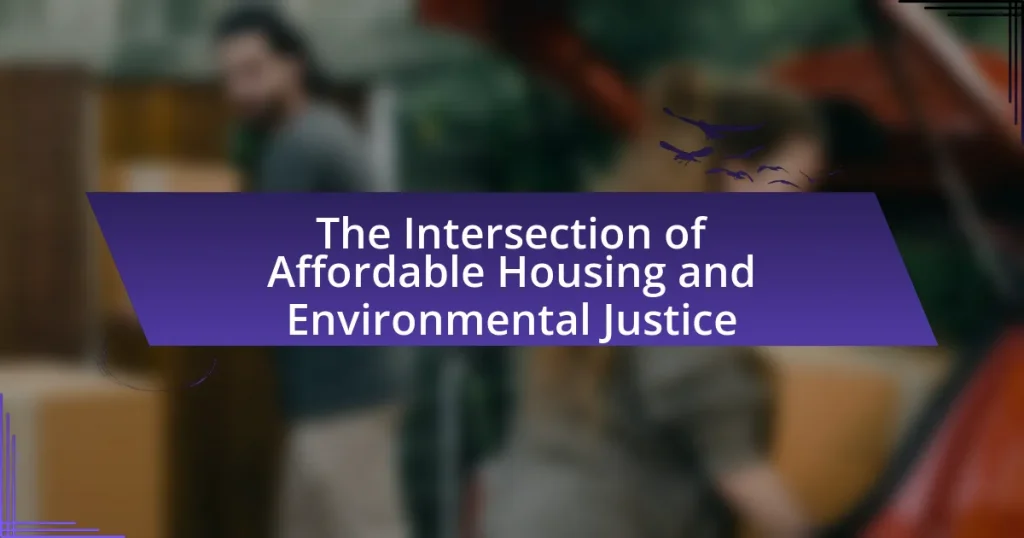The article focuses on the future of housing equity, examining the anticipated improvements through policy reforms, increased investment in affordable housing, and community-driven initiatives aimed at addressing systemic inequalities. It defines housing equity in contemporary society, highlights its key components, and discusses its impact on various demographics, emphasizing the disparities faced by marginalized groups. The article also explores current trends influencing housing equity, including demographic shifts, technological advancements, and economic factors, while predicting potential legislative changes and practical steps to promote equity in housing access.

What is the Future of Housing Equity?
The future of housing equity is expected to improve through policy reforms, increased investment in affordable housing, and community-driven initiatives. These changes aim to address systemic inequalities in housing access and affordability, particularly for marginalized groups. For instance, the National Low Income Housing Coalition reports that a significant shortage of affordable rental homes exists, with only 37 affordable units available for every 100 extremely low-income renter households. This highlights the urgent need for targeted interventions to enhance housing equity. Additionally, trends indicate a growing emphasis on inclusive zoning laws and equitable development practices, which can further promote fair access to housing opportunities across diverse communities.
How is housing equity defined in contemporary society?
Housing equity in contemporary society is defined as the difference between the market value of a property and the outstanding mortgage balance on that property. This concept reflects the financial stake that homeowners have in their properties, which can be influenced by factors such as property appreciation, market conditions, and local economic factors. According to the Federal Reserve, as of 2021, homeowners in the United States had an average equity of approximately $200,000, highlighting the significant role that housing equity plays in wealth accumulation and financial stability for families.
What are the key components of housing equity?
The key components of housing equity include property value, mortgage balance, and homeownership status. Property value represents the current market worth of a home, which can appreciate or depreciate over time, directly impacting equity. The mortgage balance is the amount owed on the home loan; as homeowners pay down their mortgage, their equity increases. Homeownership status is crucial, as equity is primarily built through owning property rather than renting. According to the Federal Reserve, in 2021, homeowners had a median equity of $185,000, highlighting the financial benefits of homeownership in building wealth through equity.
How does housing equity impact different demographics?
Housing equity significantly impacts different demographics by influencing wealth accumulation, access to quality education, and overall economic stability. For instance, homeownership rates among racial and ethnic minorities are lower than those of white households, leading to disparities in wealth; in 2020, the homeownership rate for Black Americans was approximately 44.1%, compared to 74.5% for white Americans, according to the U.S. Census Bureau. This inequity in housing contributes to a cycle of poverty, as families without home equity often lack the financial resources to invest in education or health, perpetuating socioeconomic disparities across generations. Furthermore, neighborhoods with higher housing equity tend to have better public services and amenities, which disproportionately benefits those demographics that can access these areas, further widening the gap between different groups.
Why is housing equity important for communities?
Housing equity is important for communities because it promotes economic stability and social cohesion. When individuals have equitable access to housing, they are more likely to invest in their communities, leading to improved local economies and enhanced quality of life. Research indicates that neighborhoods with higher levels of housing equity experience lower crime rates and better educational outcomes, as families can afford stable housing and access resources. For instance, a study by the Urban Institute found that equitable housing policies can reduce poverty rates and improve overall community health, demonstrating the direct correlation between housing equity and community well-being.
What role does housing equity play in economic stability?
Housing equity plays a crucial role in economic stability by providing individuals and families with financial security and wealth accumulation. When homeowners build equity in their properties, they gain access to financial resources that can be leveraged for investments, education, or emergencies, thereby enhancing their economic resilience. According to the Federal Reserve, homeowners with significant equity are less likely to default on loans, which contributes to overall economic stability by reducing the risk of housing market downturns. Furthermore, neighborhoods with higher levels of housing equity often experience increased property values and improved local economies, as homeowners are more likely to invest in their communities.
How does housing equity affect social mobility?
Housing equity significantly affects social mobility by providing families with financial stability and access to better opportunities. When individuals own homes and build equity, they can leverage that wealth for education, business investments, or other resources that enhance their social mobility. Research indicates that homeownership is linked to increased educational attainment and improved economic outcomes; for instance, a study by the Urban Institute found that homeowners are more likely to invest in their children’s education, leading to higher graduation rates. Thus, housing equity serves as a crucial foundation for upward mobility in society.

What are the current trends influencing housing equity?
Current trends influencing housing equity include rising interest in affordable housing, increased focus on racial equity in housing policies, and the impact of remote work on housing demand. The demand for affordable housing has surged due to escalating home prices, with a report from the National Low Income Housing Coalition indicating a shortage of 7 million affordable rental homes for extremely low-income renters. Additionally, initiatives aimed at addressing systemic racial disparities in housing, such as the Biden administration’s proposed investments in historically marginalized communities, are reshaping policies. Furthermore, the shift towards remote work has led to increased interest in suburban and rural areas, affecting housing prices and availability in those regions. These trends collectively highlight the evolving landscape of housing equity.
How are demographic shifts impacting housing equity?
Demographic shifts are significantly impacting housing equity by altering demand patterns and influencing housing policies. For instance, the increasing diversity in the U.S. population, with projections indicating that by 2045, non-Hispanic whites will make up less than 50% of the population, is reshaping housing markets. This shift leads to a greater demand for affordable housing options, as minority groups often face economic disparities and higher rates of housing insecurity. Additionally, younger generations, particularly millennials and Gen Z, are prioritizing urban living and sustainability, which drives demand for different types of housing and can exacerbate gentrification in certain neighborhoods. Research from the Urban Institute highlights that these demographic changes necessitate policy adaptations to ensure equitable access to housing, as traditional models may not address the needs of a more diverse population.
What trends are emerging in urban versus rural housing equity?
Emerging trends in urban versus rural housing equity indicate that urban areas are experiencing increasing disparities in housing affordability and access, while rural areas are witnessing a growing interest in affordable housing solutions. Urban housing equity is challenged by rising property values and gentrification, which disproportionately affect low-income residents, as evidenced by a 2021 report from the National Low Income Housing Coalition showing that only 37 affordable rental homes exist for every 100 extremely low-income renters in urban settings. Conversely, rural areas are seeing initiatives aimed at improving housing equity, such as the USDA’s Rural Development program, which aims to provide affordable housing options and has allocated over $1.5 billion in funding for rural housing projects in recent years. This contrast highlights the need for targeted policies to address the unique challenges faced by both urban and rural communities in achieving housing equity.
How does the aging population affect housing equity?
The aging population negatively affects housing equity by increasing demand for accessible housing while simultaneously limiting the supply of affordable options. As older adults often seek to downsize or relocate to age-friendly environments, this shift can drive up property values in desirable areas, making it harder for younger generations to afford homes. According to the Joint Center for Housing Studies of Harvard University, by 2035, nearly 80 million Americans will be over the age of 65, intensifying competition for suitable housing and exacerbating disparities in housing equity. This demographic trend highlights the urgent need for policies that address the housing needs of both older adults and younger populations to promote equitable access to housing.
What technological advancements are shaping housing equity?
Technological advancements such as blockchain, artificial intelligence, and data analytics are significantly shaping housing equity. Blockchain technology enhances transparency in property transactions, reducing fraud and enabling more equitable access to housing markets. Artificial intelligence facilitates better decision-making in lending and property management, allowing for more personalized and fair lending practices. Data analytics provides insights into housing trends and disparities, helping policymakers identify and address inequities. For instance, a report by the Urban Institute highlights how data-driven approaches can inform affordable housing strategies, ultimately promoting equity in housing access.
How is data analytics being used to promote housing equity?
Data analytics is being used to promote housing equity by identifying disparities in housing access and affordability across different demographics. For instance, cities utilize data analytics to analyze patterns in housing prices, rental rates, and demographic information, which helps in pinpointing areas where marginalized communities face barriers to housing. A study by the Urban Institute found that data-driven approaches can inform policy decisions, leading to targeted interventions that address inequities, such as zoning reforms and affordable housing initiatives. By leveraging data, stakeholders can create more equitable housing policies that ensure fair access to housing for all communities.
What role do online platforms play in housing accessibility?
Online platforms significantly enhance housing accessibility by providing a centralized space for listings, facilitating communication between buyers and sellers, and offering tools for comparison. These platforms, such as Zillow and Airbnb, aggregate vast amounts of housing data, allowing users to filter options based on price, location, and amenities, which increases transparency in the housing market. According to a 2021 report by the National Association of Realtors, 97% of homebuyers use online resources during their search, demonstrating the critical role these platforms play in connecting individuals with housing opportunities.

What predictions can be made about the future of housing equity?
Predictions about the future of housing equity indicate a potential increase in disparities due to rising housing costs and stagnant wages. As home prices continue to escalate, particularly in urban areas, lower-income households may struggle to access affordable housing, exacerbating existing inequities. According to the National Association of Realtors, the median home price in the U.S. has increased by over 30% in the past five years, while wage growth has not kept pace, leading to a widening gap in homeownership rates among different income groups. Additionally, demographic shifts, such as the aging population and increasing diversity, may influence housing equity, as younger generations prioritize affordability and sustainability, potentially reshaping market demands.
How might policy changes affect housing equity in the coming years?
Policy changes may significantly enhance housing equity in the coming years by implementing measures such as inclusionary zoning, rent control, and increased funding for affordable housing. These policies aim to reduce disparities in access to housing by ensuring that low- and moderate-income families can secure stable housing. For instance, cities that have adopted inclusionary zoning laws require developers to allocate a percentage of new units for affordable housing, which can lead to a more equitable distribution of housing resources. Additionally, research from the National Low Income Housing Coalition indicates that increased funding for affordable housing can reduce homelessness and improve living conditions for vulnerable populations, thereby promoting equity.
What potential legislation could enhance housing equity?
Potential legislation that could enhance housing equity includes the implementation of inclusionary zoning laws, which require developers to allocate a percentage of new housing units for low- and moderate-income residents. This approach has been adopted in cities like San Francisco, where it has led to the creation of thousands of affordable housing units, thereby addressing disparities in housing access. Additionally, expanding funding for housing vouchers can help low-income families afford housing in higher-opportunity neighborhoods, as evidenced by studies showing that such programs improve educational and economic outcomes for participants. Furthermore, enacting tenant protection laws, such as rent control and anti-displacement measures, can prevent vulnerable populations from being pushed out of their homes, contributing to greater housing stability and equity.
How might government initiatives evolve to support housing equity?
Government initiatives might evolve to support housing equity by implementing policies that promote affordable housing development and enhance access to homeownership for marginalized communities. For instance, increased funding for low-income housing tax credits and inclusionary zoning laws can incentivize developers to create affordable units. Additionally, initiatives like down payment assistance programs specifically targeting underrepresented groups can help bridge the homeownership gap. Evidence from the National Low Income Housing Coalition indicates that a significant portion of low-income renters face severe housing cost burdens, highlighting the need for targeted government interventions to ensure equitable access to housing.
What economic factors will influence housing equity trends?
Economic factors that will influence housing equity trends include interest rates, employment rates, and inflation. Interest rates directly affect mortgage costs; lower rates typically increase home buying, boosting equity. Employment rates influence income stability, impacting individuals’ ability to purchase homes and build equity. Inflation affects purchasing power and housing prices; rising inflation can lead to increased home values, enhancing equity for homeowners. Historical data shows that during periods of low interest rates, such as post-2008 financial crisis, housing equity increased significantly, demonstrating the strong correlation between these economic factors and housing equity trends.
How will interest rates impact housing affordability?
Interest rates significantly impact housing affordability by influencing mortgage costs. When interest rates rise, monthly mortgage payments increase, making it more expensive for buyers to finance a home. For example, a 1% increase in interest rates can raise monthly payments by approximately 10-15%, depending on the loan amount and term. This increase in payment can push homeownership out of reach for many potential buyers, particularly first-time homeowners. Conversely, lower interest rates reduce monthly payments, enhancing affordability and potentially increasing demand for housing. Historical data shows that during periods of low interest rates, such as in the aftermath of the 2008 financial crisis, housing markets often experience increased activity and rising home prices due to improved affordability.
What economic indicators should be monitored for housing equity predictions?
Key economic indicators to monitor for housing equity predictions include home price appreciation rates, mortgage interest rates, employment rates, and household income levels. Home price appreciation rates reflect the value increase of properties, directly impacting equity. Mortgage interest rates influence borrowing costs, affecting home affordability and demand. Employment rates indicate job stability, which correlates with the ability to maintain mortgage payments and invest in home improvements. Household income levels provide insight into purchasing power and financial health, essential for assessing potential equity growth. Monitoring these indicators allows for informed predictions regarding housing equity trends.
What practical steps can be taken to promote housing equity?
To promote housing equity, implementing inclusive zoning policies is essential. Inclusive zoning requires developers to allocate a percentage of new housing units as affordable for low- and moderate-income families, thereby increasing access to diverse housing options. For instance, cities like San Francisco have adopted such policies, resulting in a significant increase in affordable housing units. Additionally, providing financial assistance programs, such as down payment assistance and rental subsidies, can help low-income families secure housing. Research from the Urban Institute indicates that these programs effectively reduce housing cost burdens for vulnerable populations. Furthermore, investing in community land trusts can empower local communities to control land use and ensure long-term affordability. These practical steps collectively contribute to a more equitable housing landscape.
How can communities engage in advocacy for housing equity?
Communities can engage in advocacy for housing equity by organizing grassroots campaigns that raise awareness about housing disparities and mobilize residents to demand policy changes. These campaigns can include community meetings, educational workshops, and partnerships with local organizations to amplify their voices. For instance, the National Low Income Housing Coalition reports that advocacy efforts have led to increased funding for affordable housing programs, demonstrating the effectiveness of community-led initiatives in influencing housing policy.
What best practices can organizations adopt to support housing equity?
Organizations can adopt several best practices to support housing equity, including implementing inclusive policies, engaging with marginalized communities, and promoting affordable housing initiatives. Inclusive policies ensure that housing opportunities are accessible to all demographics, particularly those historically disadvantaged. Engaging with marginalized communities allows organizations to understand their specific needs and challenges, fostering trust and collaboration. Promoting affordable housing initiatives, such as partnerships with local governments and non-profits, can directly address the housing crisis by increasing the availability of affordable units. According to the National Low Income Housing Coalition, there is a shortage of 7 million affordable rental homes for extremely low-income renters, highlighting the urgent need for these practices.



